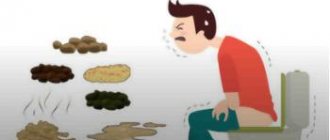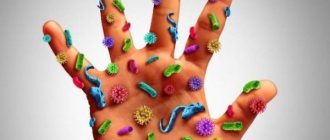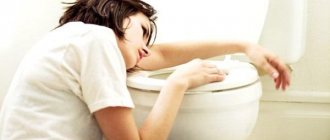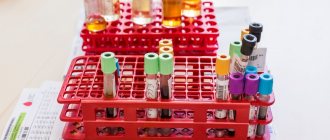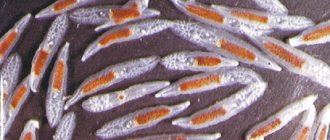Routes of transmission
There can be many reasons for the development of “harmful” microorganisms in the human body. One of the most basic is failure to comply with basic rules of personal and food hygiene , namely:
- eating unwashed vegetables and fruits;
- neglecting to wash hands before eating;
- eating food from dirty dishes;
- using raw water (milk) for drinking;
- insufficient heat treatment of meat products;
- neglect of cleaning the house.
However, you don’t have to be an outright slob to disrupt the body’s natural bacterial balance. As mentioned earlier, for opportunistic microorganisms inhabiting our intestines to become pathogenic, it is enough:
- constantly experience stress;
- overload yourself physically;
- move to a climate zone that is unsuitable for you.
You can also unwittingly become a carrier of dangerous intestinal infections without suspecting anything. It happens that pathogenic microorganisms inhabit the human intestines, but the person does not observe any specific symptoms of intestinal infections, for example, the following:
- elevated temperature;
- body aches;
- vomit;
- stomach ache;
- diarrhea;
- flatulence;
- lack of appetite;
- bad breath.
When a patient comes to a therapist with a complaint about the symptoms described above, he will refer him for a bacteriological examination of stool. Further treatment is determined by a more specialized specialist - a gastroenterologist or an infectious disease specialist .
Rules for taking the analysis
To obtain a reliable result of a bacterial analysis of stool, it is necessary to strictly adhere to the rules for collecting biomaterial. So, in order to properly pass the tank analysis, it is necessary 2-3 days before submitting the material to the laboratory to stop using rectal suppositories, Vaseline, castor oil, laxatives, medications containing iron, bismuth.
The containers for submitting feces for culture must be sterile. A special container with a lid and a stick for collecting stool, which can be purchased at a pharmacy, is best suited. Since in order to obtain reliable results of bacteriological examination of stool for intestinal infections, the container must be sterile, it is better not to open the jar for collecting biomaterial again and not to touch its inner surface with your hands.
The act of defecation must occur naturally (the use of laxatives, rectal suppositories, and enemas is strictly prohibited). Before collecting material for analysis, you must urinate in the toilet, since the result will not be reliable if urine gets into the feces container. Defecation is performed in a clean vessel (not in the toilet). Then, using a special stick that comes with the container, the feces are collected and placed in a container for collecting feces for bacterial analysis. The volume of material should not exceed a third of the container (2 teaspoons).
The container with the biomaterial must be delivered to the laboratory as soon as possible. If it is not possible to deliver immediately, then the collected material can be refrigerated for up to 8 hours .
Biomaterial for bacterial culture of a baby's stool can be collected from a clean diaper or underwear of the child. It is better not to take feces from a diaper, as the analysis may give an incorrect result.
Sometimes a rectal smear is taken for disgroup. In this case, all manipulations to collect material for analysis are performed by a nurse. The patient lies on his side and spreads his buttocks, and the nurse, using a special rectal swab, collects material for bacteriological examination of stool for dysbacteriosis.
You have to wait on average 1 week for results. The shelf life of the disgroup analysis is counted from the day the research results are received and is 10 days.
Stool analysis for tank culture
Bacteriological examination of stool (tank culture) is an examination method to determine intestinal flora and identify possible pathogens of the disease.
Indications for analysis
Indications for bacteriological examination of stool are:
- suspicion of the infectious nature of the disease;
- control of treatment of infectious disease;
- reduced immunity and frequent colds;
- study of intestinal microflora after long-term treatment with antibiotics and chemotherapy;
- when applying for work involving contact with people and food products;
- to prevent infection after contact with a patient with an intestinal infection.
Preparing for analysis
In order for the stool analysis to be informative and accurate, it is necessary to follow some rules not only before the analysis itself, but also during the collection of stool for the laboratory. It is worth remembering that a stool test for bacterial culture is carried out either before antibiotic therapy, or 8-10 days after its cessation, otherwise the result will be distorted. Also, you should not get tested if you are taking NSAIDs (non-steroidal anti-inflammatory drugs, for example, diclofenac), anthelmintics and laxatives. You should not submit stool for culture after any X-ray examinations of the intestines (especially with the use of barium) or enemas. All this can negatively affect the result of the analysis.
Stool collection technique
The actual collection of feces for seeding should take place in the morning. It is recommended to urinate before defecation so that urine does not get into the material (this will make the analysis uninformative). Also, women should not be tested during menstruation.
It is necessary to defecate on a clean sheet of paper (it is unacceptable to collect feces from the toilet, since there are other bacteria and detergent residues there) or, if you have to donate feces in a hospital setting, into a washed and dried vessel. Then, using a spoon mounted in the lid of the container, feces is collected from three different places (top, side and middle).
An important rule should be observed here: collection must be carried out in sterile packaging. If the analysis is carried out in a hospital setting, then the feces are collected in the containers that are provided there. If the test is carried out on an outpatient basis, then you can use a plastic container purchased at any pharmacy. The stool jar should be filled about a third, no more. If there is mucus or pus in the stool, it will also be partially collected.
How is stool culture performed?
After the necessary material is delivered to the laboratory (this must be done no later than three hours after collection), specialists will begin its bacteriological examination. To do this, sowing is carried out on special nutrient media that are adjusted to the needs of bacteria and are suitable for their intensive growth. Culture media vary in composition depending on the bacteria for which they are intended. And if certain pathogens grow well on some, on others they may simply die. In order to obtain the growth of bacterial colonies, the crops are placed in a thermostat, where conditions favorable to them will be maintained.
Analysis of the results obtained
After obtaining the required growth of bacteria, specialists begin to study them. Their density, shape, color and some biological features are also taken into account. Using a microscopic examination, the type of pathogen is determined, and colonies and the degree of growth are counted.
There are four degrees of microbial growth:
- 1st degree – poor growth of bacteria;
- 2nd degree – growth of up to 10 pathogenic bacteria;
- 3 degree – from 10 to 100 colonies;
- Grade 4 – more than 100 colonies.
The first two degrees will not indicate the cause of the disease, but the third and fourth degrees will be a criterion for making a diagnosis.
In addition to the degree of growth, the CFU (colony-forming unit) is calculated - a special indicator that indicates the number of microorganisms in the material being studied. The CFU norm for different bacteria will be different, since the intestines have their own normal microflora that perform a number of functions.
Normal microflora
The human intestine has its own “native” bacteria that protect the body from infections, that is, they are responsible for immunity, participate in the synthesis of vitamins and help break down some substances that enter the body with food (carbohydrates, fats, proteins). These bacteria that make up the normal intestinal microflora are:
- enterobacteria (for example, Cytobacter);
- Escherichia;
- lactobacilli;
- bifidobacteria;
- peptostreptococci;
- saprophytic staphylococci.
When analyzing stool, the number of these microorganisms will also be taken into account, since a decrease or increase in their number (CFU) may indicate dysbacteriosis and other disorders. For example, an increase in the number of Citrobacter may indicate that this bacterium was the cause of the infectious process. Citrobacter, namely some of its species, can cause various poisonings, meningitis, urological diseases and even sepsis.
Pathogenic microorganisms
Pathogenic bacteria, which normally should not be in the intestines, will be of particular diagnostic value. These bacteria, depending on the type, may indicate an infectious disease. Pathogenic microorganisms most often found in the intestines:
- clostridia;
- shigella;
- Staphylococcus aureus;
- salmonella;
- mushrooms of the genus Candida.
These bacteria can cause intestinal infections, some of which can be life-threatening.
Antibioticogram
After identifying the pathogen, it is also necessary to determine its sensitivity to various antibiotics. To do this, microorganisms are recultured onto other media containing antibacterial drugs and the effectiveness of the product is judged by the further growth of colonies. If no growth is observed (this means the death of the microorganism), the antibiotic is considered suitable for treatment.
online-registratura.ru
How the research works
Tank tests are comprehensive studies of the patient’s stool to identify pathogenic organisms in the intestines and diagnose dysbacteriosis. It is carried out using the following research methods:
- microbiological;
- biological;
- serological.
The microbiological method will allow you to see the causative agents of the disease - pathogenic bacteria - using a microscope. However, this method will only be feasible on the 7th day after infection.
Sowing on the intestinal group is carried out in this way: feces are placed in an environment that is most suitable for the growth and development of harmful microorganisms. After some time ( 5-7 days ), the type of microorganisms can be determined by the colonies that have grown during this period.
A disgroup test shows whether pathogenic microorganisms such as salmonella or shigella are present in the patient's stool. If any are present, then another study is carried out to determine the sensitivity of these pathogens to certain antibiotics.
If the pathogens die, the patient is prescribed the appropriate drug. Sowing for a disgroup is what will allow you to identify dangerous diseases in time and begin appropriate treatment.
Stool culture test
To identify pathogenic microorganisms, in modern medicine, samples are collected by inoculating human biological raw materials in a special nutrient medium where a certain temperature is maintained. Based on these microorganisms, an antibiogram is performed, that is, the sensitivity of pathogens to bacteriophages and antibacterial drugs is determined.
Stool culture tank: features of the study
Bacteriological culture has a number of advantages over other tests:
- There are no false cross-reactions.
- The sensitivity of the microbe to various drugs is revealed with maximum accuracy, which facilitates the prescription of drugs.
- All fluids of the human body are examined.
The disadvantages include the fact that you need to wait a long time for the result. The medical personnel involved in the research must be highly qualified. This method is used in gynecology, surgery, oncology, infectious diseases, and so on.
Examination of stool for intestinal group
Along with stool sampling, tests are collected from the pharynx, nasopharynx, and urine and blood tests are taken. All this is necessary for more accurate decoding. Stool culture, as is known, is placed in a certain nutrient medium, but to identify a specific disease, this medium can be different. For example, to study one of the pathogens, feces are placed in an elective or selective environment, where one microbe progresses and the rest are inhibited. In some cases, a differential liquid is used, in which all bacterial cultures are identified. To make identification more accurate, cultures are also placed on a solid medium.
When the collected samples are already in a nutrient medium, it is installed in a thermostat, where a certain humidity and temperature are established in order to accelerate the growth and development of microbes. After a certain time has passed, the culture of microorganisms is examined under a microscope, and the material is first stained with special solutions. During such an inspection, specialists make an assessment of shape, color and density. Sometimes additional studies are carried out to determine the predisposition of microbial colonies to decompose organic and inorganic compounds.
Then doctors count the pathogens and determine how many microbes one microorganism can reproduce. In order for the quality of the analysis result to be at the highest level, certain rules must be followed. Otherwise, the examination becomes pointless. To do this, it is necessary that the collection utensils and instruments are as sterile as possible. It is advisable that laboratory workers hand over the dishes to the patient, after which the patient will collect stool or urine.
If a person took antibiotics the day before, they must tell their doctor about this and stop taking the medications 10 days before the tests are collected.
You need to take tests in the very morning, collecting them with a sterile spatula in the amount of 15-35 g. At the same time, you need to make sure that no other material gets into the container. Many people collect feces in the evening, which is unacceptable. You should also not use laxatives or give an enema. The duration of the examination for general flora is from 4 to 7 days.
Interpretation of the sowing tank
The studied material is divided into 4 degrees according to the degree of growth:
- On a liquid nutrient medium, bacterial growth is rather weak, but on a solid medium, no growth is observed.
- On a dense medium, the growth of one species reaches 10 colonies.
- The growth of bacteria reaches numbers from 10 to 100.
- At this degree, colonies grow to more than 100.
In the first two degrees, bacteria are not considered the causes of the disease, but in the two extremes, they indicate the etiology, that is, microorganisms are the main cause of the disease. The results of the analysis of intestinal groups are also necessary so that the doctor can prescribe high-quality and effective treatment.
Stool culture for dysbacteriosis is done when a person has problems with the gastrointestinal tract, especially if this is accompanied by weak stools, nausea and vomiting. With this disease, sowing is deciphered in four degrees:
- There is no foreign microflora, and in the aerobic area of the microbiocenosis the changes are insignificant.
- The amount of lactoflora and bifidoflora has been significantly changed, the number of Escherichia has been increased.
- Lactoflora and bifidoflora are practically absent, but hemolytic staphylococcus appears.
- The microbiocenosis has been changed, pathogenic microorganisms have increased, Protea has been detected.
Tests for disgroup and infections involve the study of microflora, mainly its composition. Because it is the main part in the work of the stomach and intestines. The microflora consists of lactobacilli and bifidobacteria. Only 10% of the total composition can be distinguished as hemolytic staphylococcus, Escherichia coli, bacteroides, and fungi.
All these microorganisms found in the microflora, as a rule, have a certain amount. If during the study these intestinal infections exceed the norm, it means that they are the root cause of the disease dysbacteriosis. If treatment is not started in time, then the bacteria begin to grow rapidly, which can lead to unpleasant consequences.
The period for research using the usual method is from 7 to 10 days, but if desired, you can do a rapid analysis, which takes only a few hours. It is worth noting that the condition of the stool changes in the middle stage of the disease. In the later stages, you may notice streaks of blood, mucus and diarrhea. The smell becomes very unpleasant. All these signs also occur in other diseases, so timely testing for culture is considered a very important step.
101analiz.ru
Decoding the results
Table of normal indicators for tank analysis
| Typical E. coli | 107 — 108 |
| E. coli lactose negative | 5 |
| E. coli hemolytic | No |
| Microbes of the genus Protea | 2 |
| Other opportunistic enterobacteriaceae | 4 |
| Non-fermenting bacteria | 104 |
| Enterococcus | 105-8 |
| Staphylococcus hemolytic | No |
| Staphylococci (saprophytic, epidermal) | 104 |
| Bifidobacteria | 109-10 |
| Lactobacilli | 107-8 |
| Bacteroides | 7 |
| Clostridia | No more than 105 |
| Yeast mushrooms | 3 |
Bacteroides are gram-negative bacteria that inhabit the human intestine. The composition of bacteroids in the feces of a healthy person usually does not exceed
Bifidobacteria play a very important role in all processes that occur in the gastrointestinal tract. They synthesize vitamins B and K, thanks to which the body better absorbs vitamin D. Bifidobacteria also help strengthen the human immune system. The content of bifidobacteria (norm) is 109-10 CFU/g.
Typically, tank analysis determines the quantitative ratio of “beneficial” and opportunistic microorganisms in the human intestine. If the patient is healthy, then there should be no pathogenic bacteria.
Lactobacilli live in the human mouth and intestines. In women, lactobacilli also live in the vagina. Their main function is bactericidal. The fact is that microbes are not able to survive in the acidic environment of these cultures. Everyone knows the ability of lactobacilli to ferment milk. It is with their help that kefirs, yoghurts, and fermented baked milk are made. In addition, lactobacilli are active catalysts for phagocytosis (destruction of harmful viruses and bacteria by phagocytes).
How to take the test correctly
The reliability of the analysis depends on the quality of material collection, so all points must be carefully followed. The meaning of all actions is sterility, so that bacteria, which are always in the external environment and have nothing to do with humans, do not get into the material.
Preparing for the examination
During preparation, the following conditions must be observed:
- For 2 days, stop taking medications containing bismuth (De-nol, Vikair, Vikalin, Ventrisol, Bismofalk and the like) and iron (Tardiferon, Ferroplekt, Ferrum-lek);
- wait for the natural act of defecation, if necessary, postponing the date of delivery of the material;
- If you need to take any medications daily, inform your doctor and laboratory assistant.
What you should never do:
- use laxatives, their use distorts the result;
- use candles, even glycerin ones;
- give an enema, microenemas (Microlax, Norgalax), including.
Preparing containers
To collect stool, pharmacies have disposable sterile containers with a spoon. The most expensive one costs up to 10 rubles, there are also much cheaper ones. The container should not contain any liquid or preservative (just tell the pharmacist that it is for dysbiosis analysis). Good laboratories provide such containers upon request, adding the cost to the price of the analysis.
It is not advisable to use other containers - baby food jars, etc. - as even boiling does not ensure sterility. At home, it is impossible to achieve the sterility required for laboratory glassware.
Collection of material
- To collect material, use a clean, dry vessel - for bedridden persons. For walkers, place a new plastic bag in the toilet so that the bag covers the entire surface. For children - lay out a clean diaper; you cannot take it from the diaper (the diaper, and especially the diaper, absorbs liquid).
- After defecation, open the container, remove the spoon (attached to the lid), without touching anything inside the container.
- Use a spoon to collect the material from the middle without touching the edges.
- Fill the container no more than one-third full.
- Screw on the lid.
- Place a clear inscription on the container: last name and initials, year of birth, date and time of collection of the material (some laboratories require a referral number).
How long can collected material be stored?
The container with the material must be delivered to the laboratory within 3 hours. If you bring it later, the laboratory simply will not accept it, since the analysis cannot be reliable.
While traveling, it is advisable to avoid direct sunlight and overheating. It is best to place the container, wrapped in a plastic bag, in a bag or briefcase. You cannot place it on the front panel of the car, keep it near the stove or wear it under a fur coat. In winter, the temperature that is in your bag or briefcase is enough; there is no need to wrap it up.
Some laboratories allow the material to be accepted after 8 hours if it has been stored in the refrigerator. This needs to be clarified in the laboratory.
Classification
Tank tests can help a doctor diagnose not only gastrointestinal infections, but also other diseases. For example, tank tests for gyno (vaginitis) can diagnose bacterial vaginosis in women. As mentioned earlier, lactobacilli live not only in the intestines, but also in the vagina of women in a certain amount. A violation of the ratio of opportunistic, pathogenic and “beneficial” bacteria can provoke a disease such as bacterial vaginosis.
A doctor may order a blood test for dysgroup if the patient's symptoms indicate blood poisoning. Indications for tank blood test:
- elevated temperature (for a long time);
- suspected infectious diseases.
Usually, a blood culture test is taken before starting a course of antibiotic therapy, since after using antibiotics one cannot hope for a reliable test result.
Source: brulant.ru
Preparing for analysis
Before taking a stool test, you must stop taking medications that affect the functioning of the gastrointestinal tract for several days. Preparation for the test may also include a special diet that must be followed for five days before the test.
Before taking a stool test, you should not do enemas, take laxatives, or eat foods and substances that have a distinct color. Also, before the analysis, you cannot take an X-ray of the intestines - during this procedure, a radiopaque liquid is used, which will not allow a reliable and complete analysis.


